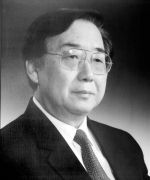Awards
- Thomas Hart Benton Mural Medallion - 1986
- Seminar for American and Chinese University Presidents
- Indianapolis, Indiana
- Presenter: John William Ryan

Guoguang Mu began teaching at Nankai University after receiving a Ph.D. from the Department of Physics in 1952. He founded and directed the university's Institute of Modern Optics, the first higher education institution in China to confer Ph.D. degrees in both optics and optical engineering. He served in other leadership roles at the university, including dean of the Department of Physics and the Graduate School, and as university president from 1985 to 1995.
An opticist, Mu focused his academic career on optics and application optics. His research included white-light optical image disposal, optical mode recognition, machine vision, color recovery of faded film, archives storage of color film, Fresnel holography, 3D target recognition of series code filtration, and optical neural network mode and its application in recognition.
Mu designed and developed several optical instruments and their components: the white-light optical image treatment system, the optical correction lens used for screen coating of color TV kinescope, and the optical projection system of aerial defense warning radar signal.
Along with Yuan Lin Zhan, Mu wrote "the first classical fundamental book for optical physics and one of the most widely used optics textbooks in China," Optics (1964). He also wrote and published over 100 scientific research papers, held two patents, and received the Ho Leung Ho Lee Prize for exceptional Chinese scientist.
Mu was awarded the Thomas Hart Benton Mural Medallion by President Ryan during the Seminar for American and Chinese University Presidents in Indianapolis in 1986, named a fellow member of The Optical Society in 1990, elected a member of the Chinese Academy of Sciences in 1991, elected a member of the Third World Academy of Sciences in 1993, and elected a fellow of the Academy of Sciences for the Developing World in 1994.
Mu passed away in Tianjin, China, in 2012.